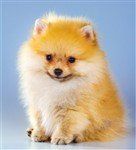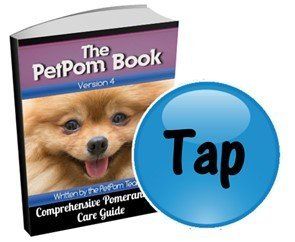Why Pomeranians Can Look So Different
Overview
We looked into our Member suggestions once again, and came across many emails from Pom owners wanting to know why it is that Pomeranians look so very different, despite all being the same breed. And this is an excellent question that brings up all sorts of interesting facts.
This section is going to discuss the various factors that come into play that affect the appearance of the Pomeranian puppy or dog that all come together to create unique and individual dogs.
We are going to look at the following elements:
• What happened during the development of the Pom that allowed for such diverse traits within one breed
• The way in which color creates such different looking Pomeranians
• How body structure plays a role
• How the Pom changes as he matures and how the age of the dog can make a huge difference in his overall appearance
• The way in which grooming can make two Pomeranians look so very different
And of course, you'll see some adorable photos that will help explain all of the above. So if you are wondering why Pomeranians can look so different, let's take a closer look.
Please note:
PetPom is reader-supported, and some of the product suggestions on this page are affiliate links. As an Amazon Associate we earn from qualifying purchases. This is at no extra cost to you and helps keep this site running.
The Development of the Breed to Create Diverse Physical Traits
While some types of dog breeds were developed to hold one particular color or 1 certain pattern of coloring, the Pomeranian has quite a different story.
Its ancestors were medium to large sized Spitz dogs that mainly lived in the Arctic. Most were only found with white coats; there was little variation.
During 1700's breeders worked on creating a smaller dog and during this time the size of the German Spitz was reduced by approximately 50%, which allowed for dogs that were 30–50 lbs. (14–23 kg).
During the late 1800's when Queen Victoria became smitten with the breed and established a kennel to bring down the size even further, what was considered to be a small Pomeranian at that time was in the 12 pound range (5.4 kg).
Color started to be introduced. Now, if breeders of that time had only wanted to bring reds into the Pomeranian line, today we would most likely only have white, orange and red solid Poms and partis that held combinations of those three. However, a huge variety of coloring
was introduced. And each color brings about even more…
For example, bringing in black (which is dominant over white) produced the following different Pomeranians: pure black, black and white parti, blue (over time blue was created as it is a diluted black) & white and blue.
Bringing brown into the Pom line gave us the following different Pomeranians: solid brown, chocolate, light tan, and partis (which a mixture of all shades of brown ranging from dark to light).
As breeding was further developed, recessive genes produced even more variety. For example, with Wolf Sable, neither dam nor sire needs to be a wolf sable color; as long as both carry the recessive gene for this coloring, puppies may be born wolf sable.
It must be noted that unlike many other breeds, colors were not bred OUT. During the development and refining of many other dogs breeds, if a certain 'non-desired' color were produced, those dogs would not be bred in an effort to produce only desired colors.
However, with the Pom, it become quite popular to have rare and exotic coloring and for this reason no color was even considered to be undesirable and therefore over many generations just about every color imaginable was brought into the bloodline.
By the early 1900's the collective goal to produce a very small lap dog was reached with a breed standard weight of 3 - 7 lbs. (1.36 - 3.175 kg). Though, there are many Pomeranian dogs that are larger and we will discuss this ahead.
Coat Color Can Make Pomeranians Look a Lot Different
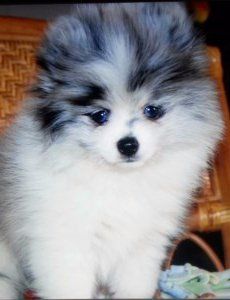
Merle Parti, Panda
photo courtesy of owner: Lori Vadason, Pomarazzi Pomeranian
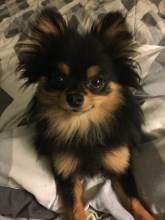
Black & tan parti, Likinia, photo courtesy of owner: Kyrsten
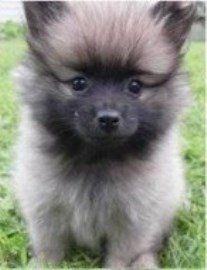
Wolf sable, Gizmo, photo courtesy of owners: Jason & Candice
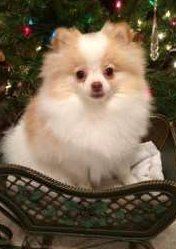
White and tan parti, Abby, photo courtesy of owners: Belina & Allen Hood
Color & Pattern Differences
Not only different colors, but patterns in the coat create such a diverse look with the Pomeranian. With parti's color may fall anywhere. Merle creates its own unique look with a splattering effect. Brindling causes a striping effect. In addition, eye color
can be different as well, ranging from chocolate brown to light blue.
It should be noted that there is no color, coat thickness or other physical trait that applies to one gender but not the other. Both male and female Pomeranians
will have the same physical appearance.
Are you taking care of your Pom's teeth?
This breed is VERY prone to tooth decay. If you are not doing at-home dental care now, there can be terrible consequences in the future. Learn how to take care of a Pomeranian's teeth.
How Body Structure Creates Such Different Looking Pomeranians
There are 2 parts to this: facial structure and body size:
Facial Structure -
The official face structure of the Pomeranian breed is a fox like face. Until very recently (relatively speaking in the breeding world), this held unwavering with reputable breeders - the goal was to produce dogs that fit the strict standards (fox face) - or to come as close as possible, since there is no such thing as a 'perfect dog'.
Striving to meet guidelines is done for the betterment of the breed and to maintain integrity. With this said, there are always some pups that have faults. One type of fault is a stop that slants down. Keep this in mind as we read ahead...
Within the past 20 years or so toy dogs gained enormous popularity. And with this surge in demand, the idea that the media fostered for people obtaining 'teacups', 'toys' and 'teddy bears' created an almost manic rush for some breeders to try and produce tiny dogs that took on a similar appearance to a stuffed animal. They would pair dogs that had faults - such as the slanted stop that we just spoke about - to purposefully create a new look.
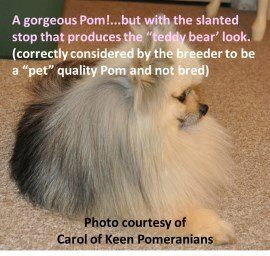
For this reason, a flatter face with a shorter snout were traits that some breeders worked on producing - even though this did not and does not fit the standards of well-known kennel clubs.
With just a few generations, fox face Poms were bred with teddy bear Poms and before too long there became a new way in which this breed could look so dissimilar. There are now a vast majority of Poms with varying size snouts (and sometimes flatter foreheads).
Again, it should be mentioned that Poms that do not have a fox like
face (longer snout) do not meet the breed standard and ethical breeders will sell these dogs as 'pet' as opposed to show without breeding rights so that the fault is not passed down.
For some Poms, this can be an issue since dogs with flat facial features can actually suffer from structural related health issues, similar to what Brachycephalic dogs (Pugs, Boxers, Bull dog, Shih Tzu) suffer from (stenotic nares ,elongated soft palate, etc.) that can cause trouble breathing and heat stress among other issues). This is most often the case with the very compact babydoll face - in which the snout is exceedingly short, cramming together nasal passages.
Size -
There is general agreement between all major kennel clubs regarding size for the show ring. The AKC stipulates 3 - 7 lbs. (1.36 - 3.175 kg), the CKC (Canada) also calls out for 3-7 lbs. (1.8-3 kg) and the KC (Kennel Club - UK) calls for an ideal weight of 1.8 to 2 kg (4 to 4 1/2 lbs.) for males and 2 to 2.5 kg (4 1/2 to 5 1/2 lbs.) for females.
The FCI classifies the Pom as the smallest of the Spitz (Toy Spitz) with a height of 20 cm +/- 2 cm, meaning that a range of 18 to 22 cm (7.09 to 8.67 inches) is expected which is very close to the height seen with most AKC show Poms.
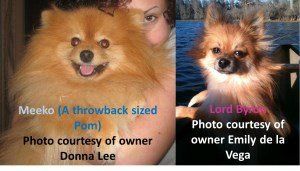
So, in general, we are looking at a dog that varies between 3 and 7 pounds per the breed standards. However, there are many Pomeranians that are larger than this.
In our comprehensive Pomeranian survey that asked a range of questions including those regarding size, in looking at 3104 adult Poms, just 32% (993) fit within the weight range of 3 to 7 lbs (1.36 to 3.175 kg). The majority, 65% of Poms (2,018) were over 7.5 lbs. (3.4 kg). In fact, 29% of adult Poms were over 10 lbs. (4.5 kg). Note that the full survey results are found in PetPom's GIANT Book of Pomeranian Care.
Keeping all of this in mind, a fully grown 3-pound Pom is going to look a lot different than a fully grown 10-pound dog. These dogs will have different bone structure; both can be at healthy weights.
Another thing to keep in mind is that a 3 lb. adult Pom is going to look a lot different than a 3 lb. Pom puppy (that will be, perhaps, a 9 lb. adult when mature).
Are you keeping your Pom safe?
How many of these Pomeranian Safety Tips
are you following?
Why Pomeranians Look Different as They Mature
We mentioned above that a Pom with small bone structure may be 3 lbs. fully grown, but there may be another Pomeranian that is 3 lbs. when still considered to be a
puppy. And these 2 Pomeranians are going to look very dissimilar.
There are 2 main reasons for this: The coat & the 'Puppy VS Adult' body structure. Let's take a closer look.
The Coat -
While just about every dog breed has a changeover from puppy to adult fur as they grow, this change is very pronounced with the Pomeranian breed. Most of you know this as the 'Puppy Ugly' stage. Poms are born with soft, short coats and this is often just 1 layer of fur.
Sometime around 4 to 9 months of age, the coat rapidly falls out. During this time, Poms can look very funny and odd, hence the term 'Puppy Uglies'. The adult, double coat grows in by the age of 10 to 14 months and the Pomeranian looks completely different.
As an adult, the inner layer is now very dense. The outer layer is comprised of longer guard hairs.
Another vital element to note is that during this time of change, the coloring often changes as well and this can make a huge difference for each individual Pomeranian.
Body Structure -
Pom puppies are rather round. Legs are short, the snout is small. They are rather stout and plump. However, there are many changes that occur as a Pom grows. The legs, snout and back will lengthen. This creates a much leaner body.
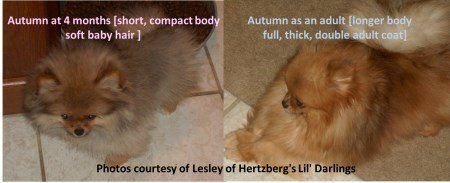
While a very fluffy coat may conceal this a bit, an adult Pom looks very different than a younger puppy with a much more lean, longer body. This in and of itself makes Poms look very different from each other.
How Grooming Techniques Can Create a Huge Difference with Pomeranians
Coat Products
- There are some elements that can cause the coat to fall flat, look frizzy, or otherwise not be as it should. If you take a Pom that has a coat with poor texture and Pom that has a healthy thick coat, those dogs are going to look amazingly different.
For any owner who may wonder why their Pomeranian is not fluffy or the coat isn't in good shape, the answer usually will be found in these elements that can drastically change the quality and appearance of the fur:
1. Shampoo
- The wrong shampoo can strip the cuticles which makes for a very dull and often dry-looking coat. It's vital to use a shampoo that has a pH between 6.5 and 7.5, no soaping agents (it should have plant-based cleansers), and zero additives like chemical preservatives, sulfates, parabens, and artificial coloring or perfumes.
If you're looking for a terrific shampoo for your Pom, Earthbath All-Natural Shampoo
 is amazing. The Oatmeal & Aloe is a favorite and other formulas like the Tea Tree Oil is good for hot spot issues and Mediterranean Magic is great if a Pom's coat holds odors.
is amazing. The Oatmeal & Aloe is a favorite and other formulas like the Tea Tree Oil is good for hot spot issues and Mediterranean Magic is great if a Pom's coat holds odors.
2. Conditioner
- When a Pom is bathed, the hair cuticles open up. A good conditioner is then needed to smooth them back down. If this does not happen, the coat can look quite terrible, with lots of dry frizzy ends. And, if a conditioner is too oily and is not easily rinsed out of the coat, this will weigh the fur down, making it flat.
If you're looking for the right conditioner to smooth the cuticles down but without causing the fur to lie flat, Earthbath All-Natural Conditioner
 is perfect. Once you rinse out the shampoo, massage this in for about 5 minutes and then rinse it out with warm (not hot) water.
is perfect. Once you rinse out the shampoo, massage this in for about 5 minutes and then rinse it out with warm (not hot) water.
3. Coat spray
- Even if you use fantastic bathing products, what about the weeks in between the baths? If you are leaving the coat bare, it is going to be vulnerable to all of the elements. Hot sun, cold arid winter air, and contact friction (any time a Pom rubs against a surface) can do a number on the coat if it's not protected. You may notice a dulling, drying, and less bounce.
Use a leave-in spritz like The Stuff
 to keep the coat in great shape. As an added plus, this helps the coat repel urine splashed, allergens, and irritants, and helps prevent tangles. Do not douse the coat; just do a light spritz each time you brush.
to keep the coat in great shape. As an added plus, this helps the coat repel urine splashed, allergens, and irritants, and helps prevent tangles. Do not douse the coat; just do a light spritz each time you brush.
4. Type of grooming tools.
There are many different types of brushes because there are many different types of coats on all of the various dog breeds. Using the wrong type of brush can do a variety of things. Let's take a quick look.
1)
Two level steel comb - This should be used before you brush to separate hairs and check for tangles. If you don't do this, and your brush does not go deep enough, there can be inner mats that affect how the hairs fall. For this, something like the Andis 7-1/2-Inch Steel Comb
 works well; the end with the wider teeth is used on the main body and the end with the narrow teeth are used on the face and other small areas like the paws.
works well; the end with the wider teeth is used on the main body and the end with the narrow teeth are used on the face and other small areas like the paws.
2)
Slicker brush - This is needed to reach deep into the dense two-layer coat of this breed and pull out dead hairs. If you are using a brush that does not reach down enough or simply skims over the coat, the coat will be filled with shedded hairs, weighing it down. For this, the Lil Pals Slicker Brush
 works great; it is small enough for you to follow all the curves on the body and has cushioned pin tips for comfort.
works great; it is small enough for you to follow all the curves on the body and has cushioned pin tips for comfort.
3)
Pin brush - You may think you are done once you use the slicker brush, but a pin brush can be great for finishing touches. The coat is now clear of dead hairs and debris and there are no mats, so the pin brush can allow you to fluff the coat out. The Safari Pin Brush for Dogs
 is recommended, this is a good size for most Poms and has polished tips.
is recommended, this is a good size for most Poms and has polished tips.
Please note:
Do not brush a dry coat, always use a leave-in spray as previously covered under '3. Coat Spray'.
Trims/ Shaves - While dogs
like Boo the Pomeranian may be famous, we can't condone shaving the coat to achieve that sort of look. Shaving a Pom does create a dog that looks entirely different than a 'normal' Pom, however when you shave that closely, you are cutting into the inner layer and doing so may damage the coat in such a way that it may never be able to grow back as it once was. In many cases, the coat will look very patchy and uneven as it struggles to grow.
Unless there is some sort of skin issue or health condition that requires the coat to be shaved, there is no reason to do this. A Pom does not need to be shaved down in the summer time.
Trims on the other hand, can make a Pomeranian look very different, but in a good way that is healthy for both coat and skin. With some Poms, guard hairs grow out too long, unevenly or both. Going around the body to even things out - usually trimming off 1/8 to 1/4 inch (.45 to .63 cm) can really allow the coat to stand up and give that 'ball of fluff' look. It is also recommended to trim any hairs that may have grown out past the paw pads.

A Final Word
While Pomeranians can look very different than one another, color and size is a matter of personal preference and we are sure that you'll agree that all Poms are beautiful. Expect changes along the way, as your Pom matures and appreciate each stage.
You may also like:
How to Care for a Pomeranian in the Summer
- Great tips to prepare for hot, humid months. Ways to keep your Pom comfortable and safe.
How to Care for a Pomeranian in the Winter
- Helpful care tips for cold, dry and snowy winter months.

